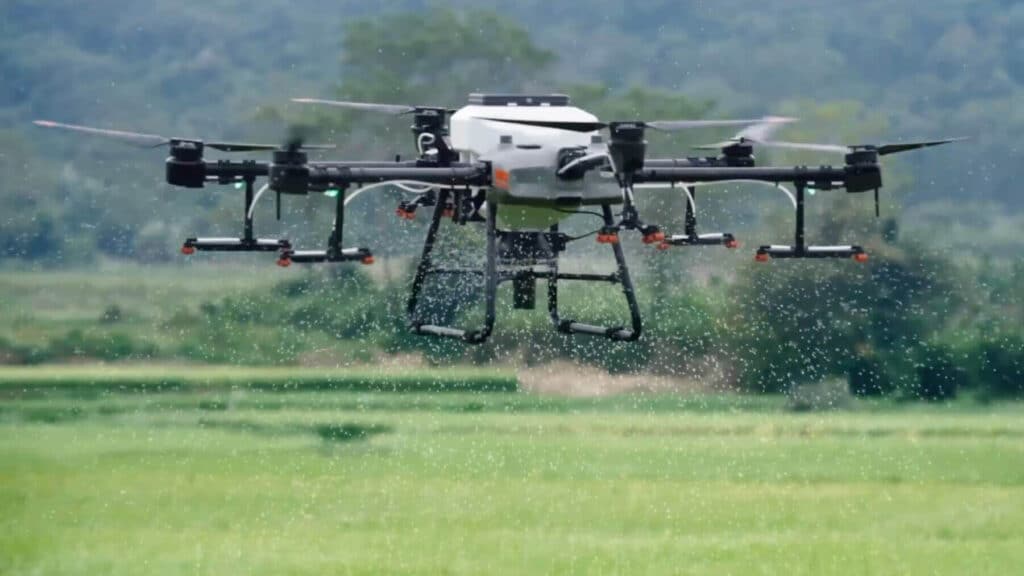
Spraying drones aren’t as basic as their name may suggest. Yes, their main function is to spray pesticides, fertilizers, and seeds. But they are smart, sophisticated machines that greatly improve resource and time efficiency in clever ways. So let’s take a look at how the DJI Agras T30 and T10 make agriculture smarter.

Autonomous
For starters, they don’t require a person to control them manually. You just set the designated area of the farm, and they fly over and start spraying. Additionally, the drone is self-aware of its own payload level. So when they need a refill on the pesticide/fertilizer/seed, they automatically stop at the ground station. Once refilled, they continue their mission. The drone can even sweep the edge automatically. DJI’s intelligent route mode even makes the flight paths for you.
Spherical Radar System
The T30 and T10 come equipped with a spherical radar that can detect obstacles in all directions. Most drones have directional obstacle sensors, but they also have blind spots. DJI’s Spherical Radar System eliminates blind spots and can even detect tall trees, powerlines and other obstacles regardless of dust and light interference. The spherical radar system makes the T30 and T10 exceptionally safe.
Resource Efficiency
You can instruct the drone to follow a precise flow rate which ensures that your entire farm is sprayed uniformly. Alternatively, if you want to have a more conditional approach, you can use DJI’s Spreading System 3.0. DJI’s new spread system supports variable spreading that adjusts to the farm’s specific needs. This ensures that there is no wastage of resources. In essence you are more resource-efficient while improving yield by giving your farm the optimal level of fertilizers, pesticides and more.
Branch Targeting Technique
Not all plants have the same size or shape, so why should the drone’s spread angle be singular? For example, fruit-bearing orchards are taller than your field crops and must be sprayed from a different angle. The Agras T30 has you covered, the drone can transform and alter the angle of the spray into the orchard configuration to more optimally spray the plants.
Dual FPV Cameras
Both the DJI Agras T30 and T10 come equipped with FPV cameras on the front and back. These cameras give you greater situational awareness, ensuring that the drone is safer at all times. It also lets you check on the status of the flight. With the improved visibility and control during missions, you can improve the safety and reliability of missions.
Water, Dust and Corrosion Resistant
You can describe farms in many ways, but neat isn’t one of them. They can be dusty, dirty and wet. Just as tools on a farm need a good wash at the end of the day, so do drones— especially when switching between pesticides and fertilizers in the payload. In the past, we’ve had to restrict ourselves to air blowers and gentle swaps, but the DJI Agras T30 and T10 are IP67 rated and are corrosion-proof. So you can now safely operate the drone in challenging environments and even give them a proper wash at the end of it.
Spraying Drones in Agriculture
The rise in drones in agriculture has allowed farmers to increase yields without applying more fertilizer or pesticides. This then cuts down on the amount of resources that need to be expended in agriculture. The drones can map the crops that need fertilising or spraying before acting on the information.
This increase in efficiency often becomes extremely important for farmers, especially in agriculture (the second largest user of water), where resources are limited, and prices rise accordingly.
With drones, farmers can save money in the long term and increase their yields. The drones can also help reduce the environmental impact of agriculture by minimising the amount of pesticide used. In this way, drones are an environmentally-friendly technology. This improves crop yield and reduces the amount of resources required for agriculture. Drones also help farmers reduce their production costs by saving valuable time in surveying agricultural land.
When it comes to the usage of drones in agriculture, it is important to consider their ability to act on the data they collect. For example, agricultural drones can fertilise and spray crops with great accuracy. This allows for better use of resources and ultimately improves crop production. So improve your farm production with a spraying drone! Not convinced yet? Get in touch to arrange a cost-free demo.